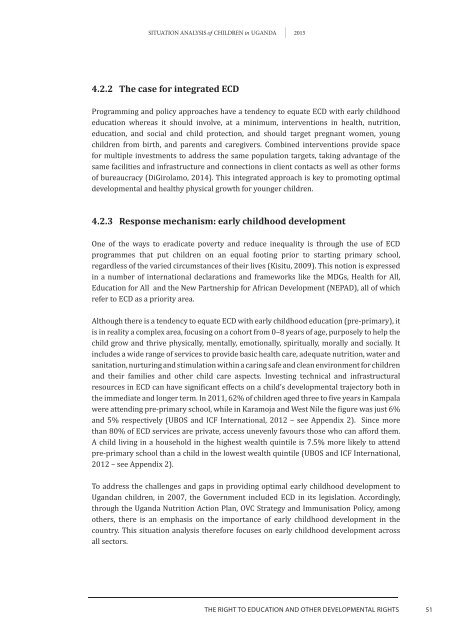Situation analySiS
1TNu802
1TNu802
You also want an ePaper? Increase the reach of your titles
YUMPU automatically turns print PDFs into web optimized ePapers that Google loves.
<strong>Situation</strong> <strong>analySiS</strong> of Children in uganda 20154.2.2 The case for integrated ECDProgramming and policy approaches have a tendency to equate ECD with early childhoodeducation whereas it should involve, at a minimum, interventions in health, nutrition,education, and social and child protection, and should target pregnant women, youngchildren from birth, and parents and caregivers. Combined interventions provide spacefor multiple investments to address the same population targets, taking advantage of thesame facilities and infrastructure and connections in client contacts as well as other formsof bureaucracy (DiGirolamo, 2014). This integrated approach is key to promoting optimaldevelopmental and healthy physical growth for younger children.4.2.3 Response mechanism: early childhood developmentOne of the ways to eradicate poverty and reduce inequality is through the use of ECDprogrammes that put children on an equal footing prior to starting primary school,regardless of the varied circumstances of their lives (Kisitu, 2009). This notion is expressedin a number of international declarations and frameworks like the MDGs, Health for All,Education for All and the New Partnership for African Development (NEPAD), all of whichrefer to ECD as a priority area.Although there is a tendency to equate ECD with early childhood education (pre-primary), itis in reality a complex area, focusing on a cohort from 0–8 years of age, purposely to help thechild grow and thrive physically, mentally, emotionally, spiritually, morally and socially. Itincludes a wide range of services to provide basic health care, adequate nutrition, water andsanitation, nurturing and stimulation within a caring safe and clean environment for childrenand their families and other child care aspects. Investing technical and infrastructuralresources in ECD can have significant effects on a child’s developmental trajectory both inthe immediate and longer term. In 2011, 62% of children aged three to five years in Kampalawere attending pre-primary school, while in Karamoja and West Nile the figure was just 6%and 5% respectively (UBOS and ICF International, 2012 – see Appendix 2). Since morethan 80% of ECD services are private, access unevenly favours those who can afford them.A child living in a household in the highest wealth quintile is 7.5% more likely to attendpre-primary school than a child in the lowest wealth quintile (UBOS and ICF International,2012 – see Appendix 2).To address the challenges and gaps in providing optimal early childhood development toUgandan children, in 2007, the Government included ECD in its legislation. Accordingly,through the Uganda Nutrition Action Plan, OVC Strategy and Immunisation Policy, amongothers, there is an emphasis on the importance of early childhood development in thecountry. This situation analysis therefore focuses on early childhood development acrossall sectors.thE rIGht to EDUCatIoN aND othEr DEvELoPMENtaL rIGhtS51




